道路工程材料Road Engineering Materials ch5
Road Engineering Materials ch4
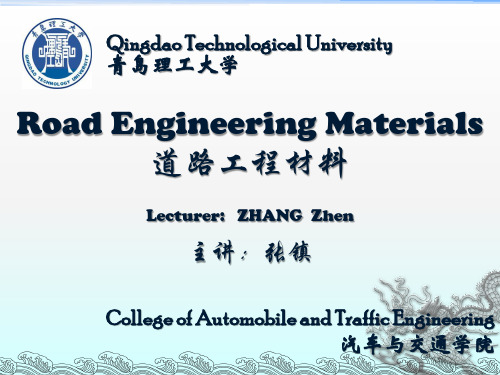
Lean, harsh or extremely wet concrete
Recommended slumps for various type of construction
Type of construction
In the slump test, the number of mm the original center of the cone sinks or settles uniformly is measured to the nearest 5 mm. The measurement is called slump.
Normal weight concrete (2350-2500kg/m3) Lightweight concrete (up to 1900kg/m3) Heavyweight concrete (up to 3200kg/m3)
4.1 Properties of fresh concrete
Ch4 Concrete and Mortar
新拌水泥混凝土:指在施工过程中使用的 尚未凝结硬化的水泥混凝土。
4.1 Properties of fresh concrete(新拌砼) 4.2 Mixing 拌合, Placing 浇筑 and Curing养护 4.3 Properties of Hardened Concrete 4.4 Mix proportioning and design
a. Fill the cone using standard procedure b. Strike off excess
c. Raise the mold and measure the displacement of the original center of the specimen
道路工程材料

道路施工材料道路施工材料泛指用于道路和桥梁工程及其附属造物所用的各类建筑材料,主要包括土、砂石、沥青、水泥、石灰、工业废料、钢铁、工程聚合物、木材等材料及它们组成的混合料。
道路工程材料是道路工程建设于养护的物质基础,其性能直接决定了道路工程质量和服务寿命。
1.砂石材料砂石材料是石料和集料的统称,石料和集料是道路与桥梁工程结构及其附属物中用量最大的一类才材料,石料制品课直接用于砌筑结构物或用于道路铺面,集料也可直接用于铺筑道路路面基层或垫层,但更多的是制备成沥青混合料、水泥混凝土和基层混合料,用于铺筑沥青路面面层或路面基层。
岩石质量主要取决于其造岩矿物和成岩条件,在道路工程中常用岩石品种为石灰岩、花岗岩,玄武岩,辉绿岩等;岩石的主要理学指标为单轴无侧限抗压强度,物理常数为密度,含水率和吸水率,在季节性冰冻地区应考虑所用岩石的抗冻性。
集料是不同粒径矿物组成的混合物,集料的密度对其物理理学性能有这重要的影响,而且是混合料组成设计的重要参数。
用于道路路面结构的粗集料应具备足够的抗压碎性,抗磨耗性和抗冲击性,用于表层的粗集料还应具有足够的抗磨光性,集料的理学性能分别用压碎性磨耗性,磨耗值,冲击值和磨光值等指标表示。
集料的颗粒组成用级配表示,集料级配与集料的密实度和内摩擦阻力有着直接的关系,也是进行矿质混合料组成设计的主要依据。
矿物混合料是由两种或两种以上的集料按一定比例组成的,确定这个比例关系的过程称为配合比设计。
矿质混合料的配合比的计算方法有数解法(计算法,规划求解法)和图解法。
用于建造基础的水泥混凝土拌合料制备用碎石或le石颗粒的最大尺寸不应大于70mm,而用于路面铺筑不能大于40mm。
用于水泥混凝土拌合料制备的碎石或le石不应含有多于25%的板状与针状粒料,二粉状及粘土粒料也不应超过1%。
2.水泥和石灰水泥和石灰石是道路工程建筑中使用较为广泛的无机胶凝材料。
该类材料经物理化学过程能产生强度和胶凝能力,将砂石等散装材料胶凝成整体,或将构件结合成整体。
道路工程材料期末重点总结

道路工程材料期末重点总结一、介绍道路工程材料是指在道路建设或维护过程中使用的各种物质,包括路基材料、沥青混合料、水泥混合料和辅助材料等。
这些材料不仅对道路的结构和性能起着关键作用,还直接影响道路的使用寿命和行车安全。
因此,对道路工程材料的研究和选用至关重要。
二、道路工程材料的分类根据其用途和性质,道路工程材料可以分为以下几类:1. 路基材料:主要由天然土壤或矿物颗粒组成,用于构建道路的路基层和基底层,具有承载能力和排水性能;2. 沥青混合料:由沥青、矿料和填料按一定配合比混合而成,用于制造柔性路面层,具有较好的弯曲性能和抗水性能;3. 水泥混合料:由水泥、矿料和填料按一定配合比混合而成,用于制造刚性路面层,具有较高的强度和耐久性;4. 辅助材料:包括黏合剂、增稠剂、防腐剂等,用于改善道路工程材料的特性和性能。
三、路基材料1. 路基材料的性质要求:路基材料的主要性能要求是承载能力、抗冻性和排水性。
承载能力是指路基材料能够承受的荷载;抗冻性是指路基材料在低温环境下的抗冻破坏能力;排水性是指路基材料能够有效排水,防止路基内水分的积聚。
2. 常用的路基材料:(1) 天然土壤:天然土壤是指未经改良的现场土壤,包括黏土、砂土和砾石等。
天然土壤可以根据其塑性指数和颗粒分布曲线等指标来进行分类和评价。
(2) 工程填土:工程填土是指通过填筑方式得到的土壤,包括回填土、垫层土、坚实填料和悬浮填料等。
工程填土可以通过加水密实和加冻融循环试验等来评价其稳定性和抗冻性。
3. 路基材料的改良和加固:为了改善路基材料的性能,常常采用物理改良和化学改良的方法。
物理改良包括加固和加水密实,可以通过夯实、振动和加荷方法来实施。
化学改良包括雪融剂和土壤改良剂的使用,可以改变土壤的结构和性质,提高其稳定性和抗冻性。
四、沥青混合料1. 沥青混合料的组成和性能:沥青混合料由沥青、矿料和填料组成,通过混合而成。
沥青是一种黑色的胶状物质,具有粘接性和弹性;矿料是指石子和矿石等坚硬颗粒;填料是指填充物料,可以提高沥青混合料的体积稳定性和耐久性。
道路建筑材料 I (英文)精品PPT课件
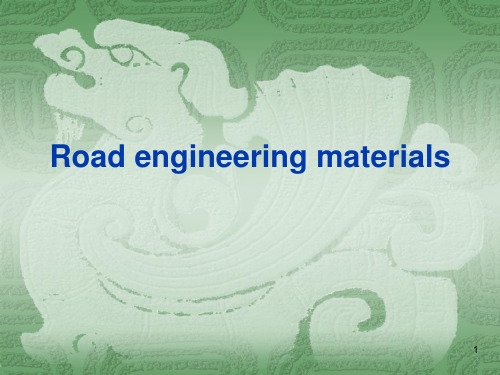
Mag岩matic Ro浆cks
花岗岩
岩
sed沉imentary 沉R积积oc岩ks 岩
Metamorphic Rocks 变质岩
9
1.1 Building stone
—— Magmatic Rocks(岩浆岩)
形成:由火山喷发出的岩浆冷凝而形成岩石。由于喷发后冷却过程的不同, 岩浆岩又可分成深成岩(plutonic rock)、喷出岩(extrusive rock)和 火山岩(volcanic rock)三种。
5
1.1 Building stone
Brief Introduction Nowadays, stone also is a one of the building materials used in some special place.
6
1.1 Building stone
main content
石灰岩
Lime stone
17
1.1 Building stone
——Typical of sedimentary rocks :sandstone
砂岩(sandstone):
由石英颗粒和黏土(沙粒含 量超过50%)组成,结构稳 定,通常呈淡褐色或红色, 主要含硅、钙、黏土和氧化 铁。砂岩的性能很大程度上 取决于胶结物种类,硅质砂 岩致密、坚硬耐久,耐酸, 性能接近于花岗岩;钙质砂 岩质地较软,易于加工;而 粘土类砂岩性能较差,易风 化。
有所降低。
玄武岩 basalt
13
1.1 Building stone
——Typical of magmatic rocks:basalt
凝灰岩(tuff):是一种 火山碎屑岩聚集而成, 成岩矿物主要是石英和 黏土。其组成的火山碎 屑物质50%以上的颗粒 直径小于2毫米,成分主 要是火山灰,外貌疏松 多孔,粗糙且有层理, 颜色多样。用途之一作 为生产水泥的原料。
道路工程的施工材料(3篇)
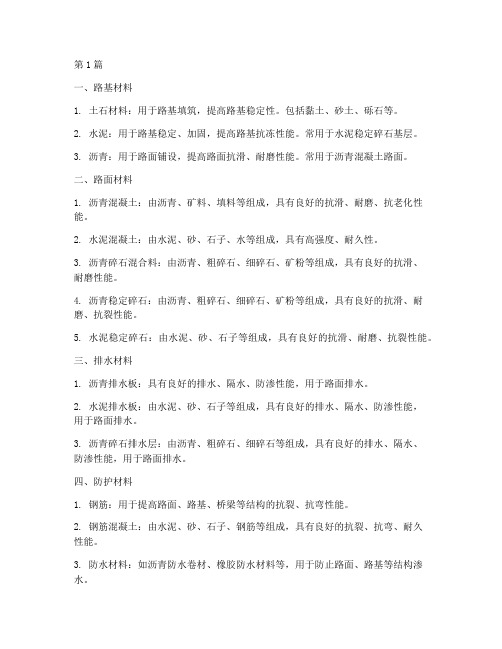
第1篇一、路基材料1. 土石材料:用于路基填筑,提高路基稳定性。
包括黏土、砂土、砾石等。
2. 水泥:用于路基稳定、加固,提高路基抗冻性能。
常用于水泥稳定碎石基层。
3. 沥青:用于路面铺设,提高路面抗滑、耐磨性能。
常用于沥青混凝土路面。
二、路面材料1. 沥青混凝土:由沥青、矿料、填料等组成,具有良好的抗滑、耐磨、抗老化性能。
2. 水泥混凝土:由水泥、砂、石子、水等组成,具有高强度、耐久性。
3. 沥青碎石混合料:由沥青、粗碎石、细碎石、矿粉等组成,具有良好的抗滑、耐磨性能。
4. 沥青稳定碎石:由沥青、粗碎石、细碎石、矿粉等组成,具有良好的抗滑、耐磨、抗裂性能。
5. 水泥稳定碎石:由水泥、砂、石子等组成,具有良好的抗滑、耐磨、抗裂性能。
三、排水材料1. 沥青排水板:具有良好的排水、隔水、防渗性能,用于路面排水。
2. 水泥排水板:由水泥、砂、石子等组成,具有良好的排水、隔水、防渗性能,用于路面排水。
3. 沥青碎石排水层:由沥青、粗碎石、细碎石等组成,具有良好的排水、隔水、防渗性能,用于路面排水。
四、防护材料1. 钢筋:用于提高路面、路基、桥梁等结构的抗裂、抗弯性能。
2. 钢筋混凝土:由水泥、砂、石子、钢筋等组成,具有良好的抗裂、抗弯、耐久性能。
3. 防水材料:如沥青防水卷材、橡胶防水材料等,用于防止路面、路基等结构渗水。
五、施工辅助材料1. 水泥:用于路基、路面、桥梁等结构的浇筑。
2. 砂、石子:用于路基、路面、桥梁等结构的填筑。
3. 沥青:用于路面铺设、防水等。
4. 水泥稳定碎石:用于路基稳定、加固。
5. 沥青稳定碎石:用于路面铺设、防水等。
6. 沥青碎石混合料:用于路面铺设、防水等。
总之,道路工程施工材料种类繁多,质量要求严格。
施工过程中,应严格按照设计要求、规范标准选用合适的材料,确保道路工程的质量和安全。
第2篇一、路基材料1. 土壤:路基工程的基础材料,需根据土壤性质进行分类,如砂性土、黏性土等。
道路工程材料慕课 -回复

道路工程材料慕课-回复道路工程材料慕课是一门介绍与道路建设相关的材料知识的在线课程。
在这门课程中,学生将学习到与道路工程材料有关的各种概念、材料特性、性能测试方法以及选择与设计准则等相关内容。
下面,我们将逐步回答与道路工程材料慕课主题相关的问题。
1. 什么是道路工程材料?道路工程材料是指用于建设和维护公路、街道、高速公路等交通基础设施的各种材料,包括但不限于沥青、混凝土、碎石、水泥等。
这些材料必须具备一定的强度、耐久性和耐候性能,以确保道路的安全、舒适和可靠性。
2. 道路工程材料的特性有哪些?道路工程材料的特性涵盖许多方面,包括物理特性、力学特性和化学特性等。
具体来说,它们需要具备良好的抗压强度、抗拉强度、抗冻融性、耐磨损性、抗滑移性等特性,以应对不同的道路使用环境和负荷条件。
3. 如何测试道路工程材料的性能?对道路工程材料的性能进行测试是确保其质量和性能达到设计要求的重要一环。
常用的测试方法包括试验室试验和现场试验。
试验室试验可以测定材料的物理和力学性质,如强度、模量、耐久性等;而现场试验则能够模拟实际使用环境,检测材料的实际性能,包括抗滑移性、附着性、声波反射等。
4. 材料选择和设计准则有哪些?在道路工程中,材料的选择至关重要,它将直接影响到道路的使用寿命和性能。
常见的材料选择和设计准则包括:- 耐久性:选择能够在不同气候条件下保持稳定性能的材料;- 可回收性:考虑可持续发展,选择能够进行再利用或回收的材料;- 成本效益:选择经济实用的材料,同时考虑其使用寿命和维护成本;- 环保性:选择对环境影响较小的材料,如低碳排放材料。
尽管面对不同的道路用途和工程要求,材料选择和设计准则会有所不同,但以上几点是考虑材料选择的基本准则。
总结起来,在道路工程材料慕课中,学生将学习到道路工程材料的定义、特性、性能测试方法以及选择和设计准则。
这些知识将帮助他们在实际道路工程中做出准确的材料选择和设计决策,从而提高道路的质量和可靠性。
道路工程材料

道路工程材料
道路工程材料是指用于建设和维护道路的材料。
道路工程材料包括沥青混合料、碎石、水泥、沙子等。
首先,沥青混合料是道路工程中常用的材料。
它由沥青和矿物铺料组成,具有良好的抗水、耐久性和耐磨性。
沥青混合料适用于各种道路,如高速公路、城市道路和乡村道路。
使用沥青混合料可以提高道路的承载能力和耐久性,延长道路的使用寿命。
其次,碎石也是道路工程材料中重要的一种。
碎石由大小不等的石块组成,被广泛用于道路的基础层和面层。
碎石可以提供良好的承载能力和排水性能,能够使道路更加坚固,不易坍塌。
此外,碎石还可以用于修建路堤和排水沟,起到加固和排水的作用。
再次,水泥也是道路工程中常用的材料之一。
水泥用于混凝土路面的建设,具有良好的强度和耐久性。
水泥混凝土路面可以承受重载交通的压力,不易出现裂缝和坑洼,提高道路的整体平整度和舒适性。
此外,沙子也是道路工程材料中不可或缺的一种。
沙子广泛应用于道路基层的填充和路面的铺设。
沙子可以提供稳定的路基和良好的排水性能,使道路更加平整和稳定。
同时,沙子还可以用于路基的加固和施工过程中的辅助材料。
综上所述,道路工程材料是建设和维护道路所必需的材料。
沥
青混合料、碎石、水泥和沙子等材料在道路工程中发挥不同的作用,使道路具有良好的承载能力、耐久性和排水性能。
选择合适的道路工程材料是确保道路质量和使用寿命的重要环节。
道路建设工程施工材料

道路建设工程施工材料随着我国经济的快速发展,交通运输业作为国民经济的重要支柱,其基础设施的建设尤为重要。
道路建设工程作为交通运输业的重要组成部分,对于促进地区经济发展、提高人民生活水平具有举足轻重的作用。
而在道路建设工程中,施工材料的选择和使用是确保工程质量、安全和进度的重要因素。
本文将从道路建设工程施工材料的角度,探讨其种类、要求及选择和使用方法。
一、道路建设工程施工材料的种类道路建设工程施工材料主要包括沥青混凝土、水泥、钢材、砂石、木材、塑料等。
其中,沥青混凝土是道路面层的主要材料,水泥是道路基层和桥梁等结构物的主要建筑材料,钢材用于道路桥梁的结构加固和施工设备,砂石用于道路基层和混凝土的制作,木材和塑料主要用于施工临时设施和支架等。
二、道路建设工程施工材料的要求1. 质量要求:道路建设工程施工材料必须符合国家相关标准和规范,具备良好的力学性能、耐久性能和环保性能。
例如,沥青混凝土应具备较高的抗剪强度、抗车辙性能和耐候性;水泥应具备较高的强度、耐久性和收缩性能;钢材应具备较高的强度、韧性和焊接性能。
2. 性能要求:道路建设工程施工材料应具备良好的施工性能,如易于搅拌、铺设和压实等。
同时,材料在运输和存储过程中应保持稳定,不易流失、损坏和变质。
3. 环保要求:道路建设工程施工材料应符合国家环保要求,尽量选用低碳、环保、可持续发展的材料。
例如,选用废弃物作为部分原材料,减少对环境的污染。
4. 经济要求:道路建设工程施工材料在满足质量、性能和环保要求的基础上,应具有较高的经济性。
在选用材料时,要综合考虑材料的价格、运输成本、施工难度等因素,力求降低工程成本。
三、道路建设工程施工材料的选择和使用1. 沥青混凝土的选择和使用:沥青混凝土的选择应根据道路等级、气候条件、交通状况等因素进行。
一般情况下,高速公路和城市主干道应选用高强度、耐久性好的沥青混凝土;次干道和支路可选用中强度、耐久性较好的沥青混凝土。
道路工程材料Road Engineering Materials CH2
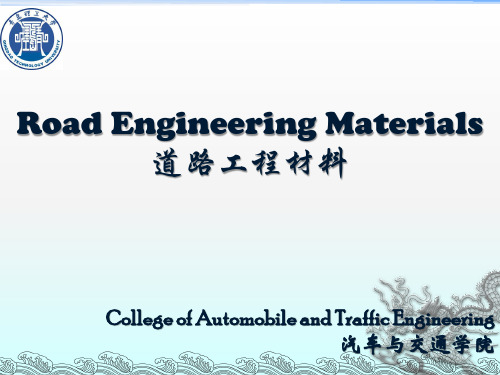
2.1.1 Based on source or method of manufacture
Natural aggregates
Natural sand is formed from weathering and decomposition of all types of rocks, the most abundant mineral constituent being quartz.
MC
Original
sample weight oven-dry oven-dry weight
weight
100
aggregate
≥4.75
沥青混合料的划分
粗集料指粒径大于2.36mm的碎石、破碎砾 石、筛选砾石及矿渣等。
细集料指小于于2.36mm的天然砂、人工砂 (机制砂)及石屑等。
矿粉mineral dust; mineral fines; filler指由 石灰岩或者岩浆岩等憎水性碱性石料经磨 细加工而得到的,在混合料中起填充作用 的,以碳酸钙为主要成分的矿物质粉末, 也称填料。
✓Oven dry (OD) ✓Air dry (AD) ✓Saturated surface dry (SSD)
✓Wet
Moisture content
➢Very important as it influences the w/c;
➢SSD state is most often used as a reference, although it is more difficult to obtain than OD state; ➢Absorption is very important;
堆积密度,指单位体积(包含物质颗粒固体及其
道路工程材料(申爱琴版)-作业-集料&水泥(英文版)
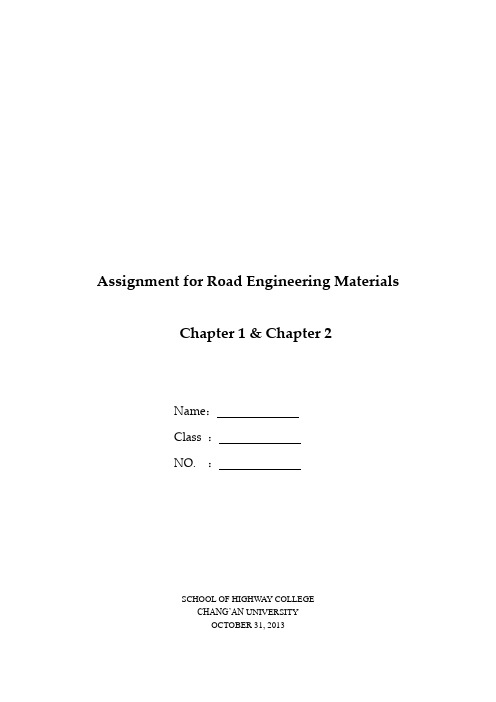
Assignment for Road Engineering MaterialsChapter 1 & Chapter 2Name:Class :NO. :SCHOOL OF HIGHW AY COLLEGECHANG’AN UNIVERSITYOCTOBER 31, 2013Chapter one Aggregate1.Here are two kinds of stone, and the test results are shown in following table.Which kind of stone has better performance?Solution:Step 1, the porosity of these two stone can be calculated as the following formula:n=(1−ρdρt)×100%And the n A=0.07> n B=0.Step 2, the value saturation-water coefficient of A stone is 0.75, which is higher than theB stone’s, 0.65.Step 3, the higher porosity of stone is, the better water absorption gets and the worse frost resistance is. So is the saturation-water coefficient. From what has been mentioned above, the stone A apparently gets a higher porosity of stone and saturation-water coefficient, so the stone A is worse at frost resistance.Conclusion: stone B has better performance.2.Please describe the difference between strength indexes of stone and aggregate,and the test methods.Solution:a)The major strength index for stone is uniaxial compressive strength. The result ofmeasuring uniaxial compressive strength test is represented as resilient modulus R=PA with triaxial chamber with external LVDT’s and load cell. And the prepare sample can be cube (in road engineering) or cylinder (in bridge engineering).b)The major strength index for aggregate is crushing value. And the test method is in thebelow.Procedure to determine Aggregate Crushing Valuei)The aggregates passing through 12.5mm and retained on 10mm IS Sieve are oven-driedat a temperature of 100 to 110o C for 3 to 4hrs.ii) The cylinder of the apparatus is filled in 3 layers, each layer tamped with 25 strokes ofa tamping rod.iii) The weight of aggregates is measured (Weight ‘A’).iv) The surface of the aggregates is then leveled and the plunger inserted. The apparatus is then placed in the compression testing machine and loaded at a uniform rate so as to achieve 40t load in 10 minutes. After this, the load is released.v) The sample is then sieved through a 2.36mm IS Sieve and the fraction passing through the sieve is weighed (Weight ‘B’).vi) Two tests should be conducted.Aggregate crushing value = (B/A) x 100%.3.Please describe the classification of aggregate from deferent perspectivesSolution:Solution:Notification: There is some other types of aggregate by different standards●Crashed gravel●Crushed sand●Stone chip●Filler●Slag4.There are two kinds of aggregate, and the test results are shown in followingtable. Please describe the difference of the performance of these two kinds of aggregate.Solution:The lower crushing value is, the better anti-crushing performance aggregate gets. And so is the Los Angeles abrasion ration. So, the aggregate B has a better anti-crushing and anti-crushing and abrasiveness performance.The higher polishing value is, the better anti-slip performance aggregate gets. So, the aggregate A has a better anti-slip performance.5. Please describe the definition, the test and the calculation methods of densitiesof aggregate, and give the rank of different densities.Solution:a) True density:Definition: the mass of a unit volume of the impermeable portion of material, including the solid and impermeable pore.. Test: Le Chatelier flask methodCalculation method: ρs=m s v sb) Apparent density:Definition: the mass of a unit volume of the impermeable portion of material, including the solid and impermeable pore. Test: Wire basket methods Calculation method: ρa=m s v s +v nc) Bulk density:Definition: the mass of a unit volume of material under natural status, including solid, permeable and impermeable pores. Test: Wire basket methods for coarse aggregate Flask method for fine aggregate Calculation method: ρb=m s v s +v n +v id) Stacking density :Definition: dry mass per unit volume of aggregate under some stacking methods.including :Loose density, Tamping density, Compaction densityCalculation method: ρ=m sv s +v n +v i +v fRank: ρs >ρa>ρb>ρ6. The gradation curves of three kinds of aggregate are show in right Fig. Pleasejudge the gradation categories, and the structure of asphalt mixture consisted of these aggregate Solution:Gradation A is the gap gradation. One or more intermediate particle sizes aggregates are missing.Gradation B is the continuous gradation. The particles distribute on each sieve size from the large to small.Gradation C is the open gradation. The particles distribute on larger sieve size.7.Discuss the differences between gradation and fineness modulus of fineaggregate Have sand A and sand B, which have the same fineness modulus, the same gradation?Solution:Gradation, the particle sizes and size distribution, refers to the proportion by mass or weight of aggregate particles distributed in special particle-size ranges, not only to individual fine and coarse aggregate , but also to the combined or mixed aggregateFineness modulus, a value which statistically represents the coarse or fine condition of fine aggregate, is statistically determined by the percentage of coarse aggregateSo, the different gradation can have the same fine modulus, and the same fine modulus may not represent the same gradation.Sand A and sand B can have the same the same fineness modulus but not the same gradation.8.Sieving test results of 500g sand are shown in table. Please fill the blank, andcalculate the fineness modulus.=2.052μf=(A2.36+A1.18+A0.6+A0.3+A0.15)−5A4.75100−A4.759.The passing percentages of four aggregates are listed in the Tab.9.1 and thegradation limit are shown in Tab.9.2. Please use the graphic method and linear programming method to determine the proportions in mixed aggregate according to the mid-value of gradation limits, and calculate the composite gradation.Table 9.1Table 9.2Solution:Linear programming methodThe gradation can be designed by the Excel macro, linear programming, as long as some constraints are correctly set.Here is the gradation design sheet.Designed values of gradation are the numbers with the blue background. They are proportions of different components which are simulated by linear programming.With the assumed amount of four aggregates, the composite values can be calculated and they are displayed in the sheet.And next is the gradation curveThere are four lines in this illustration. From the legend, it can be known that the purple one, composite gradation, is always between the upper limit of gradation and lower limit of gradation and approaching the middle value of gradation. So, the design of composition gradation is qualified.Graphic method:The gradation is illustrated in the attached graph.10.The shape and surface texture of aggregate particles are important for bothcement concrete and hot mix asphalt.(1)For preparing PCC, would you prefer round and smooth aggregate orrough and angular aggregate? Briefly explain why.(2)For preparing HMA, would you prefer round and smooth aggregate orrough and angular aggregate? Briefly explain why.Solution:(1)For PCC, the round and smooth aggregate particles are desirable to improveworkability. Because the angular aggregate will be more difficult to work in place and easier to be fractured. Besides, aggregate with a rough texture are more difficult to compact into a dense configuration than smooth aggregate.(2)For asphalt mixture, angular and rough aggregate Particles are desirable to improveworkability. Because angular aggregate produce bulk materials with higher stability than round aggregate and the roughness of aggregate surface plays an important role in the way of aggregate compacts and bonds with binder materials.11.A sample of coarse aggregate from a stockpile has the following properties:Mass of wet aggregate=5298gMass of oven dry aggregate=5216gMass of aggregate in water=3295gMass of SSD aggregate=5227Determine:(a)The bulk & apparent specific density(b)The moisture content and absorption of stockpile aggregateSolution:Known: m a=5216g,m f=5227g,m w=3295g,m1=5298ga)The apparent specific densityγa=m am a−m w=2.72The bulk specific densityγf=m am f−m w=2.70b)The absorption contentw x=m f−m am a×100%=0.21% The moisture contentw x=m1−m am a×100%=1.57%Chapter two Portland Cement1.Briefly describe the hardening process of lime.Solution:The hardening process of lime comprises two parts, recrystallization and carbonification.Part 1: RecrystallizationCa(OH)2 + nH2O =Ca(OH)2∙nH2OThe reaction product has some strength by the crystal and shows some cementing properties.Part 2: CarbonificationCa(OH)2 + CO2=CaCO3The reaction product is insoluble, showing better water stability. And it makes material denser and higher strength.2.Discuss the reason of the generation of under-burnt lime and over-burnt lime.Explain the harms of over-burnt lime to concrete structure, and how to eliminate the harm.Solution:a) Under-burnt limeGeneration reason:When fire heat in limekiln is not even or raw material size is over large, some product may become “under-burnt lim e” which is considered as residue. It will reduce actual content of active ingredient.b) Over-burnt limeGeneration reason: If firing process is over heat or over time, some product may become“burned lime”.Harms:Because some expansion from “burned lime”in volume will still take place during application process and in service stage, it will result in cracking and plaster flaking.Elimination:Immersing the burnt lime in the slaking pool for several weeks so that those unslaked grain can get totally slaked. (陈伏)3.What ingredients are used for the production of Portland cement? What is therole of gypsum?Solution:Production of Portland cement starts with two basic raw ingredients: a calcareous material and an argillaceous material.The calcareous material is a calcium oxide, such as limestone, chalk or oyster shells.The argillaceous material is a combination of silica and alumina that can be obtained from clay, shale, and blast furnace slag.Besides, there are some other adjustable materials such as diatomite (SiO2),magnetite (Fe2O3), alumina (Al2O3), etc and gypsum and activity mixtures.Gypsum plays a role as a retarder to regulate the setting time of the cement in the concrete and a control amount of gypsum can prevent some side-effect.4.What are P.I, P.II, P.O, P.S, P.P, P.F shorted for?Solution:P.P means Portland-pozzolana cement;P.F means Fly-ash Portland cement;P.I. and P.II. mean Portland cement;P.O. means Ordinary Portland cement;P.S. means Portland slag cement.Notation: In America, the P.I. stands for normal type Portland cement while P. II.means moderate sulfate resistance type Portland cement. And they two type are inseparable in China.5.What are the four mineral compounds in Portland cement? How do thechemical compounds contribute to the hydration, strength and other properties?Solution:The four mineral compounds in Portland cement are tricalcium silicate (3CaO·SiO2), dicalcium silicate (2CaO·SiO2), tricalcium aluminate (3CaO·Al2O3), tetracalcium aluminoferrite (4CaO·Al2O3·Fe2O3).The chemical components’ contribution of hydration can be summarized in the following table.More specifically, the relationship can be reflected by inequalities.Hydration speed:C3A>C3S>C4AF>C2SHydration heat:C3A>C3S>C4AF>C2SEarly strength:C3S>C3A>C4AF>C2SPost strength:C3S~C2S>C3A ~ C4AF6. What are the primary chemical reactions during the hydration of Portlandcement?Solution:C 3S hydration:C 2S hydration:C 3A hydration:In water without gypsumIn water with gypsum➢ After the gypsum exhaustedC 4AF hydration:It’s similar to C 3A.7. Describe the corrosion and prevention of cement stone?Solution:1) The corrosion of cement stone includes:Calcium hydroxide dissolved lost in fresh water;Erosion of sulfate;Erosion of magnesium salt;Erosion of carbonate.2) The ways to prevent cement from corrosion includes:a) Choosing right type cement which produces less amount calciumhydroxide [Ca(OH)2] during process of hydration, such as Portland slagcement;b) Selecting cement with less content of C3A;c) Improving construction technology and denseness of cement;d) Painting of waterproof coating on cement surface.8. Why should we determine the water requirement of normal consistency ofcement?Solution:There are two reasons about that:Setting time or soundness is measured only under the condition ofnormal consistencyNormal consistency expresses a state that cement pastes shows the sameconsistency.222223(3)()CaO SiO nH O xCaO SiO yH O x Ca OH ⋅+→⋅⋅+-22222)()2(2OH Ca x O yH SiO xCaO O nH SiO CaO -+⋅⋅→+⋅O H O Al CaO O H O Al CaO O H O Al CaO 2322322328219427)3(2⋅⋅+⋅⋅→+⋅322413()12C A Ca OH H O C AH ++→4134222342233332C AH CaSO H O H O CaO Al O CaSO H O++→41323423312C AH AFt CaO Al O CaSO H O +→9.Define the initial and final setting time, and briefly describe the test methods.Solution:Definition➢Initial setting timeThe initial setting time is the interval between the mixing of the cement with water and the time when the mix begins to lose plasticity,stiffening to a certain degree.It marks roughly the end of the period when the wet mix can be molded into shape➢Final setting timeThe final setting time is the interval between the mixing of the cement with water and the time when the mix completely lose plasticity.It represents the point at which the set cement has acquired a sufficient firmness to resist a certain defined pressure.Test method➢ A sample of cement paste is prepared with water required for normal consistency➢Maintained in 30min➢Penetration is repeated in every 5s near the initial setting➢The initial setting time is when the distance between the test needle and the bottom is 4mm±1mm➢Penetration is repeated in every 15min near the final setting➢The final setting time is when the distance between the test needle and the surface is 0.5-1mm10.What is the strength grade of Portland cement, and how to determine thestrength grade of a given Portland cement?Solution:Strength grade of Portland cement is classified by the compressive strength and flexural strength of the required curing day. The “MPa” is used to represent the strength grade. Portland cement has three strength grade and six types, i.e. 42.5,42.5R, 52.5, 52.5R, 62.5, 62.5R.The measuring method of strength grade of a given Portland cement is ISO method. The process are preparing the 40mm×40mm×160mm standardspecimen with cementstandard sand =13and waterscement=0.5and then measuring theflexural strength and compressive strength with enough curing days (3 days or 28 days) at the standard curing requirements.11.Please analyze the volume unsoundness of Portland cement. What effects doesvolume unsoundness bring to structures?Solution:The volume unsoundness of Portland cement means the ability to retain volume of cement paste after setting.Lack of soundness (unsoundness) is attributed to excessive amount of free lime or magnesia (ƒ-CaO, ƒ-MgO) and extra-gypsum.12.There are two batches of Portland cement from Plant A and Plant B, and theirmineral compounds are given in the following table. Please compare their differences about strength development and hydration heat features, and discuss the reasons.Solution:The Portland cement from plant B may have a higher hydration heat and lower strength development. By contrast, The Portland cement from plant A may have a lower hydration heat and higher strength development.The amount of C3A plays a dominate role in the hydration heat. And there is more C3A in the Portland cement of plant B. So, it may have a higher hydration heat.The mount of C3S plays a dominate role in the strength development. And there is more C3S in the Portland cement of plant A. So, it may have a higher hydration heat.。
道路建筑材料5

道路建筑材料是道路工程中不可或缺的组成部分,其质量直接关系到道路的使用寿命和行车安全。
本文将重点介绍道路建筑材料中的五种常见类型,包括沥青混凝土、水泥混凝土、砂石材料、排水材料和防护材料,并对每种材料的特点、应用范围和施工要求进行详细阐述。
一、沥青混凝土沥青混凝土是道路建设中使用最广泛的材料之一,具有良好的耐久性、抗滑性和降噪性能。
沥青混凝土路面可分为普通沥青混凝土和改性沥青混凝土两大类。
普通沥青混凝土主要由沥青、粗细集料和填料组成,适用于城市道路、高速公路和机场跑道等场所。
改性沥青混凝土在普通沥青混凝土的基础上,通过添加橡胶、树脂等改性剂,提高了路面的抗裂性、抗车辙性和耐高温性能,适用于重载交通和特殊气候条件下的道路工程。
二、水泥混凝土水泥混凝土是一种以水泥为胶凝材料,通过水泥与水发生水化反应形成硬质化材料的道路建筑材料。
水泥混凝土路面具有承载能力高、使用寿命长、维修方便等优点。
根据水泥品种和掺量的不同,水泥混凝土可分为普通水泥混凝土、矿渣水泥混凝土、粉煤灰水泥混凝土等。
水泥混凝土路面适用于城市主干道、高速公路、桥梁和机场跑道等场所。
施工过程中需严格控制水泥、粗细集料、水和外加剂的质量,确保混凝土的强度和耐久性。
三、砂石材料砂石材料是道路工程中的基础材料,主要包括天然砂、人工砂、碎石和砾石等。
砂石材料在道路工程中主要用于基层和底基层的铺设,具有强度高、稳定性好、透水性强等特点。
在选择砂石材料时,应关注其粒径、级配、含泥量等指标,确保材料的质量符合道路工程的要求。
同时,砂石材料的开采和加工过程应遵循环保原则,减少对环境的影响。
四、排水材料排水材料是道路工程中用于排除路面和路基内部水分的材料,主要包括排水沥青混凝土、排水水泥混凝土和排水基层等。
排水材料的作用是提高道路的稳定性和安全性,防止水分对道路结构造成损害。
在选择排水材料时,应关注其排水性能、抗滑性能和耐久性能。
施工过程中,应严格按照设计要求进行排水层的铺设,确保排水系统的畅通。
道路工程材料课程教学大纲
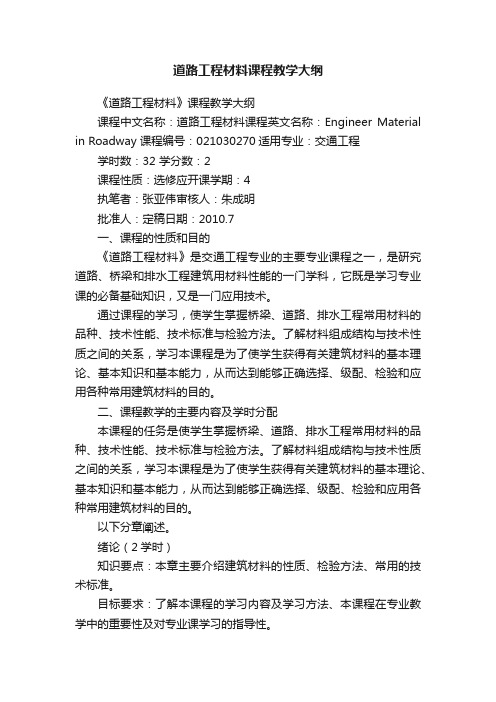
道路工程材料课程教学大纲《道路工程材料》课程教学大纲课程中文名称:道路工程材料课程英文名称:Engineer Material in Roadway 课程编号:021030270适用专业:交通工程学时数:32 学分数:2课程性质:选修应开课学期:4执笔者:张亚伟审核人:朱成明批准人:定稿日期:2010.7一、课程的性质和目的《道路工程材料》是交通工程专业的主要专业课程之一,是研究道路、桥梁和排水工程建筑用材料性能的一门学科,它既是学习专业课的必备基础知识,又是一门应用技术。
通过课程的学习,使学生掌握桥梁、道路、排水工程常用材料的品种、技术性能、技术标准与检验方法。
了解材料组成结构与技术性质之间的关系,学习本课程是为了使学生获得有关建筑材料的基本理论、基本知识和基本能力,从而达到能够正确选择、级配、检验和应用各种常用建筑材料的目的。
二、课程教学的主要内容及学时分配本课程的任务是使学生掌握桥梁、道路、排水工程常用材料的品种、技术性能、技术标准与检验方法。
了解材料组成结构与技术性质之间的关系,学习本课程是为了使学生获得有关建筑材料的基本理论、基本知识和基本能力,从而达到能够正确选择、级配、检验和应用各种常用建筑材料的目的。
以下分章阐述。
绪论(2学时)知识要点:本章主要介绍建筑材料的性质、检验方法、常用的技术标准。
目标要求:了解本课程的学习内容及学习方法、本课程在专业教学中的重要性及对专业课学习的指导性。
采用课堂教学,2学时。
第一章砂石材料(6学时)知识要点:本章主要介绍砂石材料的物理、力学、化学性质,图解法设计矿质混合料的组成。
其中难点在于级配理论、矿质混合料的组成设计和级配调整。
目标要求:掌握石料的物理性质、力学性质及路用石料技术分级的依据和技术标准。
掌握集料的物理性质、力学性质和化学性质。
理解矿质混合料的级配理论,掌握级配曲线范围的绘制方法。
掌握矿质混合料的组成设计方法(熟练掌握图解法)。
采用课堂教学,6学时。
ch5道路工程-2
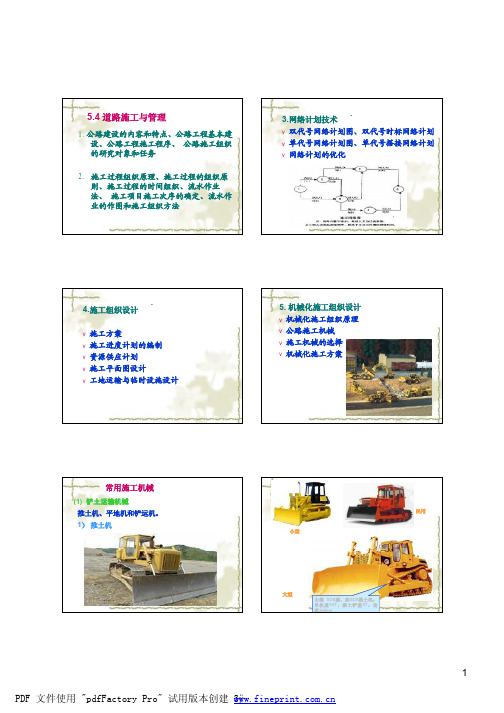
5.4 道路施工与管理1.公路建设的内容和特点、公路工程基本建设、公路工程施工程序、公路施工组织的研究对象和任务2. 施工过程组织原理、施工过程的组织原则、施工过程的时间组织、流水作业法、施工项目施工次序的确定、流水作业的作图和施工组织方法.3.网络计划技术v 双代号网络计划图、双代号时标网络计划v 单代号网络计划图、单代号搭接网络计划v 网络计划的优化.4.施工组织设计v施工方案v 施工进度计划的编制v 资源供应计划v 施工平面图设计v 工地运输与临时设施设计.5. 机械化施工组织设计v 机械化施工组织原理v 公路施工机械v 施工机械的选择v 机械化施工方案常用施工机械(1) 铲土运输机械推土机、平地机和铲运机。
1)推土机山推SD8型,如SD8推土机,单机重44T ,推土铲重4T ,功率250kw小型民用大型履带式轮胎式契块式2)平地机是一种以装有刮土刀为主,配备其他多种可换作业装置,进行刮平和整形作业的工程机械(2) 挖掘机和装载机1)挖掘(沟)机是公路工程中用于挖掘和装载土、石的重要机械。
分类:履带式、轮胎式、步履式、轨行式轮胎式履带式开挖边沟取土2)装载机是一种高效的铲土运输机械,具有推土、装载、挖掘的功能,可进行铲掘、推运、整平、装卸和牵引功能。
分类:行走方式――履带式、轮胎式动臂型式――全回转、半回转、非回转取决于使用场所、土石特性、工作环境及配套机械。
(3) 工程运输车辆运送输机电设备、工程机械等物资进场和转场;施工进行阶段运输大量的土石方、砂粒料和大宗的建筑材料。
自卸车拖车公路型非公路型(4) 石料生产机械立式冲击破碎机颚式破碎机石料破碎生产线水洗集料生产线冲击轮拖式整机多边形碾冲击轮拖式整机多边形碾.6.公路施工的技术组织措施v确保工程质量的技术组织措施v加快施工进度的技术组织措施v保证施工安全的技术组织措施v施工环境保护的技术组织措施v文明施工的技术组织措施v季节性施工的技术组织措施(冬季施工气温区划分表、雨季施工雨量区及雨季期划分表、风沙地区公路施工区划表).7.公路工程概预算v工程定额v工程造价定额v预算定额的应用v企业定额.8. 工程概预算v概、预算的作用与编制依据v概、预算文件组成v概、预算费用的组成和计算方法v概、预算文件的编制(概、预算项目表)5.5 道路检测技术v检测工作是公路施工技术管理中一个重要组成部分,是公路过程施工质量控制和竣工验收评定工作的主要环节。
道路工程材料
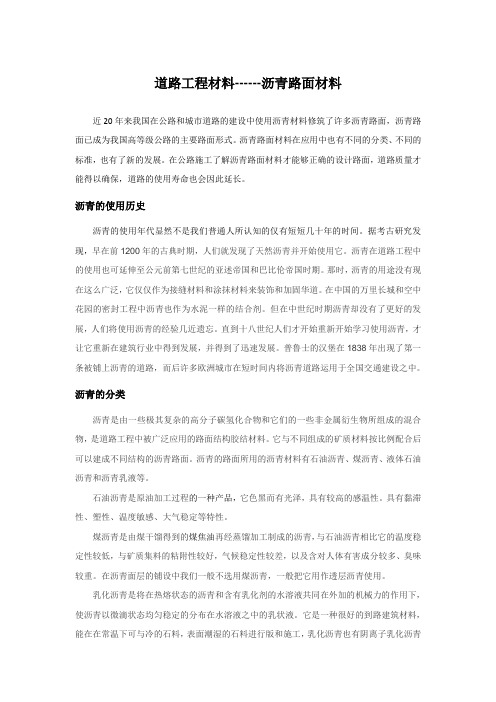
道路工程材料------沥青路面材料近20年来我国在公路和城市道路的建设中使用沥青材料修筑了许多沥青路面,沥青路面已成为我国高等级公路的主要路面形式。
沥青路面材料在应用中也有不同的分类、不同的标准,也有了新的发展。
在公路施工了解沥青路面材料才能够正确的设计路面,道路质量才能得以确保,道路的使用寿命也会因此延长。
沥青的使用历史沥青的使用年代显然不是我们普通人所认知的仅有短短几十年的时间。
据考古研究发现,早在前1200年的古典时期,人们就发现了天然沥青并开始使用它。
沥青在道路工程中的使用也可延伸至公元前第七世纪的亚述帝国和巴比伦帝国时期。
那时,沥青的用途没有现在这么广泛,它仅仅作为接缝材料和涂抹材料来装饰和加固华道。
在中国的万里长城和空中花园的密封工程中沥青也作为水泥一样的结合剂。
但在中世纪时期沥青却没有了更好的发展,人们将使用沥青的经验几近遗忘。
直到十八世纪人们才开始重新开始学习使用沥青,才让它重新在建筑行业中得到发展,并得到了迅速发展。
普鲁士的汉堡在1838年出现了第一条被铺上沥青的道路,而后许多欧洲城市在短时间内将沥青道路运用于全国交通建设之中。
沥青的分类沥青是由一些极其复杂的高分子碳氢化合物和它们的一些非金属衍生物所组成的混合物,是道路工程中被广泛应用的路面结构胶结材料。
它与不同组成的矿质材料按比例配合后可以建成不同结构的沥青路面。
沥青的路面所用的沥青材料有石油沥青、煤沥青、液体石油沥青和沥青乳液等。
石油沥青是原油加工过程的一种产品,它色黑而有光泽,具有较高的感温性。
具有黏滞性、塑性、温度敏感、大气稳定等特性。
煤沥青是由煤干馏得到的煤焦油再经蒸馏加工制成的沥青,与石油沥青相比它的温度稳定性较低,与矿质集料的粘附性较好,气候稳定性较差,以及含对人体有害成分较多、臭味较重。
在沥青面层的铺设中我们一般不选用煤沥青,一般把它用作透层沥青使用。
乳化沥青是将在热熔状态的沥青和含有乳化剂的水溶液共同在外加的机械力的作用下,使沥青以微滴状态均匀稳定的分布在水溶液之中的乳状液。
道路工程材料慕课 -回复
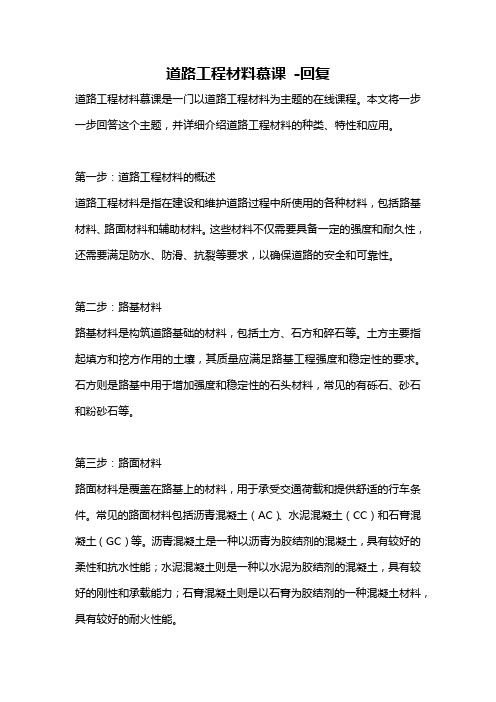
道路工程材料慕课-回复道路工程材料慕课是一门以道路工程材料为主题的在线课程。
本文将一步一步回答这个主题,并详细介绍道路工程材料的种类、特性和应用。
第一步:道路工程材料的概述道路工程材料是指在建设和维护道路过程中所使用的各种材料,包括路基材料、路面材料和辅助材料。
这些材料不仅需要具备一定的强度和耐久性,还需要满足防水、防滑、抗裂等要求,以确保道路的安全和可靠性。
第二步:路基材料路基材料是构筑道路基础的材料,包括土方、石方和碎石等。
土方主要指起填方和挖方作用的土壤,其质量应满足路基工程强度和稳定性的要求。
石方则是路基中用于增加强度和稳定性的石头材料,常见的有砾石、砂石和粉砂石等。
第三步:路面材料路面材料是覆盖在路基上的材料,用于承受交通荷载和提供舒适的行车条件。
常见的路面材料包括沥青混凝土(AC)、水泥混凝土(CC)和石膏混凝土(GC)等。
沥青混凝土是一种以沥青为胶结剂的混凝土,具有较好的柔性和抗水性能;水泥混凝土则是一种以水泥为胶结剂的混凝土,具有较好的刚性和承载能力;石膏混凝土则是以石膏为胶结剂的一种混凝土材料,具有较好的耐火性能。
第四步:辅助材料辅助材料是指用于改良和修复路面的材料,包括路面胶结剂、路用陶瓷砖、路用纤维材料等。
路面胶结剂主要是用于沥青路面的胶结和改良,常见的有沥青乳化液和沥青增粘剂等;路用陶瓷砖则是一种用于增加路面摩擦力和提高防滑性能的新型材料;路用纤维材料则是一种用于增加路面抗裂性能和延长使用寿命的材料。
第五步:道路工程材料的应用道路工程材料广泛应用于高速公路、城市道路、乡村道路等各类道路工程中。
在道路建设中,合理选择和使用适当的路基材料和路面材料可以提高道路的承载能力、耐久性和安全性。
同时,辅助材料的应用可以改善道路的防滑性能、维护性能和舒适性能。
综上所述,道路工程材料慕课是一门涉及到道路工程材料的分类、特性和应用的在线课程。
通过学习这门课程,我们可以深入了解道路工程材料的相关知识,提高道路工程质量和安全性。
道路工程材料

道路工程材料道路工程材料是指用于建设、维护和修复道路的各种材料,包括但不限于路面材料、路基材料、路面标线材料等。
道路工程材料的选择和使用直接影响着道路的使用寿命、安全性和舒适性,因此在道路建设过程中,对于道路工程材料的选择和使用需要进行精心的考虑和规划。
首先,路面材料是道路工程中最为重要的材料之一。
路面材料的选择应该充分考虑道路的使用环境、交通量、气候条件等因素。
常见的路面材料包括沥青混凝土、水泥混凝土、沥青砂浆等。
沥青混凝土具有较好的柔韧性和抗水性,适用于一般道路的建设;水泥混凝土则具有较好的耐久性和承载能力,适用于高速公路和重载道路的建设;而沥青砂浆则常用于路面修补和养护工程中。
其次,路基材料是支撑路面的基础材料,对于道路的稳定性和承载能力起着至关重要的作用。
常见的路基材料包括砾石、碎石、砂土等。
在选择路基材料时,需要考虑材料的密实性、排水性、抗压能力等因素,以确保路基的稳固和耐久。
此外,路面标线材料也是道路工程中不可忽视的一部分。
路面标线材料用于标示车道、行人通道、停车位等,对于提高道路交通的安全性和有序性起着重要的作用。
常见的路面标线材料包括油漆、热熔塑料、反光玻璃珠等。
在选择路面标线材料时,需要考虑材料的耐磨性、耐候性、反光性等因素,以确保标线的清晰和持久。
综上所述,道路工程材料的选择和使用对于道路的使用寿命、安全性和舒适性有着直接的影响。
在道路建设过程中,需要充分考虑路面材料、路基材料和路面标线材料的选择和搭配,以确保道路工程的质量和可持续发展。
同时,对于道路工程材料的研发和创新也需要不断推进,以适应不同地区和不同交通需求的变化,为人们提供更加安全、便捷和舒适的道路出行环境。
道路工程材料总结

道路工程材料随着经济的不断发展和城市规模的不断扩大,道路建设逐渐成为现代化城市建设的重要内容。
在道路建设中,道路工程材料是至关重要的组成部分,对道路的性能和使用寿命具有决定性的影响。
本文将对道路工程中常用的材料进行,希望能对道路建设者有所帮助。
1. 沥青混合料沥青混合料是道路工程中最常见的材料之一,包括石料、沥青、矿粉、填料等组成部分。
沥青混合料具有耐水、耐磨、耐老化、质量稳定性高等优点,可以提高道路的抗水浸、抗冻融、抗滑性能和耐久性等。
根据其应用的不同,沥青混合料又可以分为冷拌料、温拌料、热拌料等三种类型,具体应用需要根据实际情况进行选择。
2. 水泥混凝土水泥混凝土也是道路工程中常用的材料,适用于路面、人行道、桥梁等建设。
水泥混凝土具有高强度、耐久性高等优点,可以承受重负荷的车辆和行人的压力。
选材时需要注意水泥、骨料、砂石等配比比例,以及水泥的质量等因素,以确保水泥混凝土的质量和性能。
3. 土工合成材料土工合成材料是一种极具韧性、抗拉强度高的材料,广泛用于道路基床、路基加固、挡土墙等工程中。
该材料可以降低施工难度和加速施工进度,减少环境污染和对原有自然环境的破坏。
4. 水泥稳定碎石水泥稳定碎石是一种由石头、沙子、水泥等混合而成的材料,具有防滑、耐磨、耐久性强的特点。
通常用于路面、车道、停车场、机场跑道等场所,在增强路面承载能力、提高路面平整度等方面具有良好的效果。
5. 钢筋钢筋作为钢筋混凝土结构中的一部分,具有高强度、强度分布均匀、抗震抗裂性能好等特点。
在道路工程中,钢筋常用于路面加固、桥梁建设、隧道和防护栏的支撑等方面。
6. 砌体砌体是常见的道路建设材料,主要用于建造护坡、桥墩和隧道等固定结构。
常用的砌体材料有水泥、砖块、钢筋混凝土等,选择砌体材料需要考虑使用的场合、桥墩高度、荷载等因素。
7. 混凝土管混凝土管是一种广泛应用于道路、铁路、桥梁等建设中的管道材料。
它具有承载能力高、防腐蚀、耐久等特点,适用于建设排水管、供水管等。
- 1、下载文档前请自行甄别文档内容的完整性,平台不提供额外的编辑、内容补充、找答案等附加服务。
- 2、"仅部分预览"的文档,不可在线预览部分如存在完整性等问题,可反馈申请退款(可完整预览的文档不适用该条件!)。
- 3、如文档侵犯您的权益,请联系客服反馈,我们会尽快为您处理(人工客服工作时间:9:00-18:30)。
cutback asphalt emulsified asphalt
Cutback asphalt---- is asphalt cement that is liquefied by blending with petroleum solvents (called diluents).
ability to adhere to solid particles impermeability or water resistance
Uses of bituminous materials
roadways pavements many construction products
such as roofing felt, caulking compound, waterproofing compounds, wallboard, building paper, paints, etc.
5.1.2 Asphalts
Asphalts are cementitious materials in which the predominant constituent materials are bitumens.
Natural deposits or petroleum asphalt The consistency of asphalts varies widely
地沥青
焦油
焦油沥青
天然沥青
石油沥青
天然沥青
岩石沥青
沥青膏 慢凝
稀释(石油)沥青 中凝
乳化沥青
氧化沥青 快凝
Uses of bituminous materials
Bitumens possess a number of properties that make them useful in the construction
when used in pavement construction it is necessary to heat both the asphalt cement and the aggregates prior to mixing.
superior waterproof qualities
Pavement built using paving asphalt is waterproof and resistant to many types of chemical attack.
such as foundations,retaining walls,dams,and bridges.
Aboveground structures experience great fluctuations in environmental conditions,and waterproofing compounds should be able to withstand these changes without becoming brittle or too soft.
Asphalt cement is very sticky and highly viscous, especially prepared with the quality and consistency required in the manufacture of asphalt pavements (hotmix pavements).
When these materials undergo destructive distillation , the resulting condensate冷凝物 is tar.Further processing yields a solid or semisolid residue known as pitch.
waterproof coatings for walls and below-grade structures.
5.1.1 Tars and pitches
Tars, along with pitches, are the products of distillation of materials such as wood, coal, and shale.
Native asphalts or lake asphalts
Lake Trinidad特立尼达岛,West Indies (a 110-acre lake containing about 40 percent bitumen mixed with water, fine siliceous silt, clay, and organic matter);
5.2 Petroleum asphalt
Petroleum asphalts are classified into four types:
Asphalt cements Cutback asphalts Emulsified asphalts Air-blown asphalts
5.2.1 Asphalt Cement
Tar 焦油
Generally by-product of coke (from coal) production
When coal is heated in coke ovens, it is reduced to coke. The gases (vaporized oils) generated during the process are collected from the oven and refined. The distillation of lighter oils produces tar.
处理后得到的产品。
焦油沥青是煤、木材等有机物干馏加工所得的焦油 经再加工后的产品。
工程中采用的沥青绝大多数是石油沥青,石油 沥青是复杂的碳氢化合物与其非金属衍生物组 成的混合物。通常沥青闪点在240℃~330℃之 间,燃点比闪点约高3℃~6℃度,因此施工温 度应控制在闪点以下。
沥青(烃, 碳氢化合物)
from solid to semisolid at normal temperature
The natural deposits of asphalts are of two types:
Natural rock asphalts
Deposits of sandstone or limestone filled with asphalts
Features of bitumen
Completely soluble in carbon disulfide (CS2) Nonvolatile Nontoxic沥青分类
沥青材料分为地沥青和焦油沥青两大类。
地沥青又分为天然沥青和石油沥青
天然沥青是石油渗出地表经长期暴露和蒸发后的残留物; 石油沥青是将精制加工石油所残余的渣油,经适当的工艺
Road Engineering Materials 道路工程材料
College of Automobile and Traffic Engineering 汽车与交通学院
Ch5 Bituminous Materials
5.1 Types of asphalt 5.2 Petroleum asphalt 5.3 Properties of asphalt 5.4 Asphalt grades 5.5 Spray applications 5.6 Testing
Petroleum asphalts are used in
construction of flexible pavements roof construction (asphalt shingles, rolled roofing, and
built-up roofing), for insulation (electrical insulation and building paper) waterproofing (sprays, paints, and bituminous fabrics) canal lining seal subgrades against the migration of water Joint seals
焦油是煤炭在焦化过程中产生的。其产量约占装炉煤的 3%~4%,在常温常压下其产品呈黑色粘稠液状,密度通 常在0.95-1.10g/cm3之间,焦油又称煤焦油。
Tar pitches 焦油沥青
Tar pitches are used for built-up roofing and waterproofing of underground and aboveground construction
5.1 Types of asphalt
Bitumen is a solid,semisolid,or viscous cementitious material,natural or manufactured,and composed principally of various mixtures of complex hydrocarbons ( 烃, 碳氢化合物).
5.2 Petroleum asphalt
Petroleum asphalts are classified into four types:
Asphalt cements Cutback asphalts Emulsified asphalts Air-blown asphalts
5.2.2 Cutback Asphalts
Bermudez,Venezuela (lake asphalt containing about 65 percent bitumen)
Trinidad Lake Asphalt
特立尼达岛 特立尼达和多巴哥的主岛。与委内瑞拉东北部海岸相望,最近
